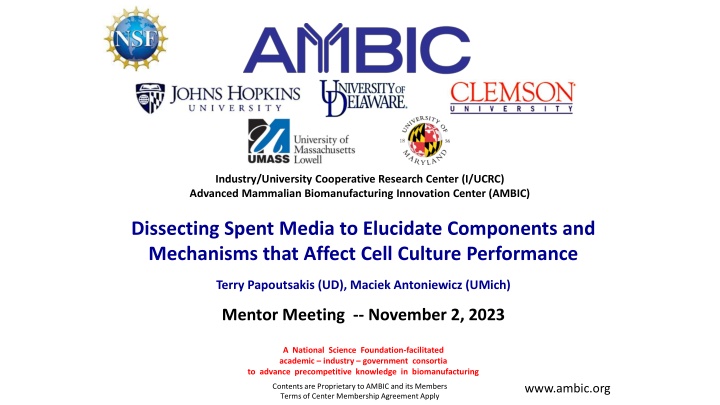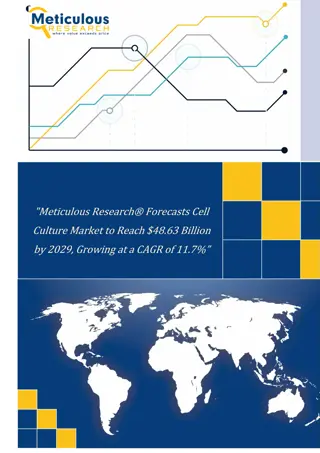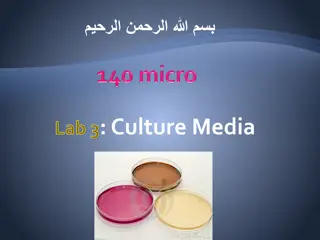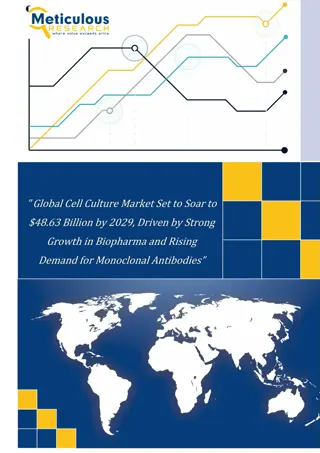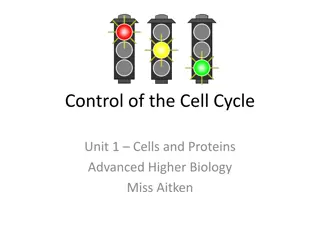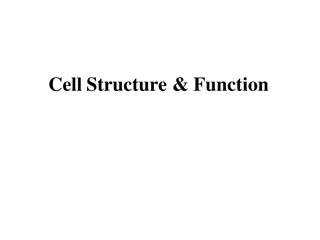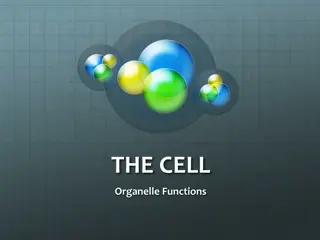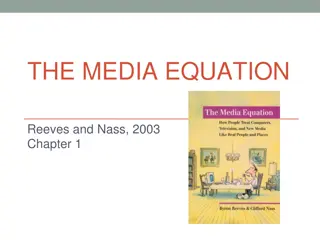Advancements in Cell Culture Performance Optimization Through Dissecting Spent Media
The Industry/University Cooperative Research Center (I/UCRC) Advanced Mammalian Biomanufacturing Innovation Center (AMBIC) is focusing on dissecting spent media to understand the components affecting cell culture performance. The project aims to identify growth-promoting and inhibiting factors in spent media, optimize removal of unwanted components, and dissect spent media using various filtration techniques. University partners are working on generating spent media, removing cell debris, exosomes, and microparticles, and analyzing components to enhance biomanufacturing processes.
Download Presentation

Please find below an Image/Link to download the presentation.
The content on the website is provided AS IS for your information and personal use only. It may not be sold, licensed, or shared on other websites without obtaining consent from the author.If you encounter any issues during the download, it is possible that the publisher has removed the file from their server.
You are allowed to download the files provided on this website for personal or commercial use, subject to the condition that they are used lawfully. All files are the property of their respective owners.
The content on the website is provided AS IS for your information and personal use only. It may not be sold, licensed, or shared on other websites without obtaining consent from the author.
E N D
Presentation Transcript
Industry/University Cooperative Research Center (I/UCRC) Advanced Mammalian Biomanufacturing Innovation Center (AMBIC) Dissecting Spent Media to Elucidate Components and Mechanisms that Affect Cell Culture Performance Terry Papoutsakis (UD), Maciek Antoniewicz (UMich) Mentor Meeting -- November 2, 2023 A National Science Foundation-facilitated academic industry government consortia to advance precompetitive knowledge in biomanufacturing www.ambic.org Contents are Proprietary to AMBIC and its Members Terms of Center Membership Agreement Apply
University of Massachusetts Lowell Project Goals Johns Hopkins University University of Maryland University of Delaware Clemson University GOAL 1 Identify growth-inhibiting and growth-promoting extracellular components found in spent media GOAL 2 Optimize removal of unwanted components from spent media to improve high cell-density cultures (perfusion/fed-batch)
University of Massachusetts Lowell Objectives Johns Hopkins University University of Maryland University of Delaware Clemson University 1. Generate spent media from fed-batch culture (or perfusion culture) 2. Culture cells in 50% fresh + 50% filtered spent media percentages can be adjusted after preliminary experiments 3. Dissect spent media using various filtration techniques separate out CHO cells, microparticles, exosomes, etc 4. Identify components that impact culture performance and optimize the removal of unwanted components
Use Filtration to Dissect Spent Media University of Massachusetts Lowell Johns Hopkins University University of Maryland University of Delaware Clemson University Small molecules (<300 Da) Peptides (~1 kDa) Proteins (10-50 kDa) Exosomes Microparticles 1 2 3 4 5 10 20 30 40 50 100 200 300 400 500 nm 1. Remove CHO cells Use gentle centrifugation Use 0.45 m or 1.0 m filtration 2. Remove exosomes and microparticles Use high-speed centrifugation Use 0.05 m or 0.10 m filtration
Use Filtration to Dissect Spent Media University of Massachusetts Lowell Johns Hopkins University University of Maryland University of Delaware Clemson University Small molecules (<300 Da) Peptides (~1 kDa) Proteins (10-50 kDa) Exosomes Microparticles 1 2 3 4 5 10 20 30 40 50 100 200 300 400 500 nm Nanofiltration 3-10 nm filters Ultrafiltration Microfiltration Millipore (0.45 m) Millipore (0.20 m) Millipore Durapore filters (0.10 m) Cytive Whatman Nucleopore filters (0.08 m, 0.05 m, 0.03 m) Whatman Anotop filters (0.02 m, 0.015 m) Millipore Ultracel filters (1, 3, 10, 30, and 100 kDa)
Generate Spent Medium (using fed-batch culture) University of Massachusetts Lowell Johns Hopkins University University of Maryland University of Delaware Clemson University Cell line: AMBIC NIH cell line Base medium: Immediate Advantage (MilliporeSigma) + 6 mM glutamine, +anti-clumping Feed medium: AMBIC feed v1.1 and 970mM glucose solution Daily feeding starting on day 4 (reset glucose to 30mM) 50% of glucose from feed, 50% from glucose stock
Produce Spent Media (fed-batch culture) University of Massachusetts Lowell Johns Hopkins University University of Maryland University of Delaware Clemson University Gluc Conc. Gln431 (M5) 40 10 35 8 30 Conc. (mM) Conc. (mM) 25 6 20 4 15 10 2 5 0 0 0 2 4 6 8 10 12 14 16 0 5 10 15 Days Days Lact261 (M3) 20 15 Conc. (mM) 10 5 0 0 5 10 15 Days
Produce Spent Media (fed-batch culture) University of Massachusetts Lowell Johns Hopkins University University of Maryland University of Delaware Clemson University Leu274 (M5) Pro258 (M4) 5 3 4 Conc. (mM) Conc. (mM) 2 3 2 1 1 0 0 0 5 10 15 0 5 10 15 Days Days
University of Massachusetts Lowell Batch cultures (50% fresh medium + 50% spent medium) Johns Hopkins University University of Maryland University of Delaware Clemson University Growth 8 Control (no spent medium) 7 6 Cell count (Mcell/mL) A 5 B 4 C 50% day 7 spent medium 50% day 9 spent medium 50% day 11 spent medium 50% day 13 spent medium 50% day 15 spent medium 3 D E 2 F 1 0 0.00 1.00 2.00 3.00 4.00 5.00 6.00 7.00 8.00 Day
Batch cultures University of Massachusetts Lowell (fresh medium + day 15 spent medium) Johns Hopkins University University of Maryland University of Delaware Clemson University Growth 8 Control (no spent medium) Control (no spent medium) 5% day 15 spent medium 7 6 Cell count (Mcell/mL) A 5 B 10% day 15 spent medium 4 C 3 D E 2 25% day 15 spent medium F 1 50% day 15 spent medium 0 0.00 1.00 2.00 3.00 4.00 5.00 6.00 7.00 8.00 Day
Potential confounding causes of toxicity University of Massachusetts Lowell Johns Hopkins University University of Maryland University of Delaware Clemson University Spent medium could be diluting critical nutrients Run experiments with: 50% fresh medium + 50% DMEM(low gluc) 50% fresh medium + 50% DMEM(low gluc) + glucose Feed medium could itself be toxic Run experiment with: 50% fresh medium + 40% DMEM + 10% AMBIC feed v1.1
Use Filtration to Dissect Spent Media University of Massachusetts Lowell Johns Hopkins University University of Maryland University of Delaware Clemson University Small molecules (<300 Da) Peptides (~1 kDa) Proteins (10-50 kDa) Exosomes Microparticles 1 2 3 4 5 10 20 30 40 50 100 200 300 400 500 nm Sartorius Vivaspin 20 Centrifugal Concentrator (5 kDa MWCO) Sartorius Vivaspin 20 Centrifugal Concentrator (100 kDa MWCO) Amicon Stirred Dialysis Cell (1 kDa MWCO) Sigma Cat.No. UFSC05001 and PLAC04310 Fisher Cat.No. 14-558-503 Fisher Cat.No. 14-558-509
Use Filtration to Dissect Spent Media University of Massachusetts Lowell Johns Hopkins University University of Maryland University of Delaware Clemson University Small molecules (<300 Da) Peptides (~1 kDa) Proteins (10-50 kDa) Exosomes Microparticles 1 2 3 4 5 10 20 30 40 50 100 200 300 400 500 nm 14 mL 1 mL Spent medium filtration: <5 min to filter 15 mL Sartorius Vivaspin 20 Centrifugal Concentrator (100 kDa MWCO) Fisher Cat.No. 14-558-509
Use Filtration to Dissect Spent Media University of Massachusetts Lowell Johns Hopkins University University of Maryland University of Delaware Clemson University Small molecules (<300 Da) Peptides (~1 kDa) Proteins (10-50 kDa) Exosomes Microparticles 1 2 3 4 5 10 20 30 40 50 100 200 300 400 500 nm 14 mL 1 mL Spent medium filtration: 30-45 min to filter 15 mL Sartorius Vivaspin 20 Centrifugal Concentrator (5 kDa MWCO) Fisher Cat.No. 14-558-503
Use Filtration to Dissect Spent Media University of Massachusetts Lowell Johns Hopkins University University of Maryland University of Delaware Clemson University Small molecules (<300 Da) Peptides (~1 kDa) Proteins (10-50 kDa) Exosomes Microparticles 1 2 3 4 5 10 20 30 40 50 100 200 300 400 500 nm 12 mL 3 mL Spent medium filtration: 90-120 min to filter 15 mL Amicon Stirred Dialysis Cell (1 kDa MWCO) Sigma Cat.No. UFSC05001 and PLAC04310
Next Steps University of Massachusetts Lowell Johns Hopkins University University of Maryland University of Delaware 1. Fed-batch to generate more spent medium Clemson University 2. Batch cultures with fresh medium +DMEM (+feed) 3. Batch cultures with fresh + dissected spent media: 29mL fresh medium + 1 mL spent medium (>100kDa) 15mL fresh medium + 15 mL spent medium (<100kDa) 29mL fresh medium + 1 mL spent medium (>5kDa) 15mL fresh medium + 15 mL spent medium (<5kDa) 27mL fresh medium + 3 mL spent medium (>1kDa) 15mL fresh medium + 15 mL spent medium (<1kDa)
